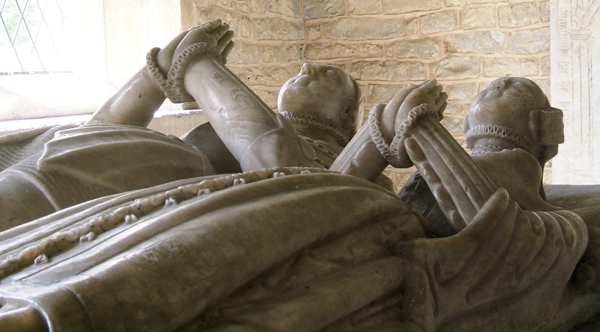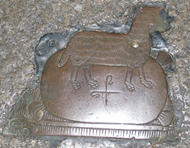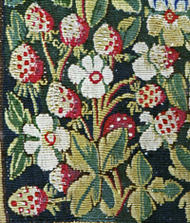Enclosure
Almost immediately William Willington ran into difficulties. In 1517 a nation-wide survey was initiated, aimed at establishing whether those who had enclosed land, whether for pasture or for parks, had caused loss of revenue to the Crown. Willington was accused of allowing houses to fall into ruin, making twenty-four people homeless in order to turn the open fields of Barcheston from use as arable – which provided employment for villagers – to meadow and pasture for sheep - when a large flock could be tended by one man.(1) His accusers are unknown, but Willington was summoned to give his account of the circumstances first in the Chancery and subsequently in the Exchequer courts at Westminster. The hearings took nearly two decades to complete, at the end of which he was acquitted of the charges.(2)
Local documents support his account,(3) suggesting that where tenements abandoned before his purchase of approximately 750 acres in 1507 had already been converted to pasture that usage continued; the details of the transaction suggest that he was not solely responsible for depopulating the village and that part of the manor had already been enclosed, presumably by the Duraunts.(4)
Only by his death in 1555 had the settlement at Barcheston been reduced to church, rectory, manor and mill. As its tax records show Willington remained an actively inhabited settlement; the parish had fourteen communicants in 1563.(5)
Family Feuds
Willington married Anne Middlemore around 1505; their seven daughters all married advantageously into local families either already established or on the rise. His second marriage, to another Anne Middlemore in 1545, seems to have caused friction in the family. Willington named his nephew, William Barnes as his heir at Barcheston, favoured over the children of the first marriage.(6) Almost immediately after Willington’s death a fight broke out over the terms of his will when Barnes attempted to keep the wool shorn from sheep he claimed were his, only to be caught by the widower William Sheldon, once husband of Willington’s fourth daughter, at the ford over the river Stour.(7) The incident spurred Sheldon, to whom Barcheston had been bequeathed in 1536 but later withdrawn, to sue Barnes and other family members; Barnes counterclaimed.(8) Subsequently the sons-in-law amongst whose wives the lands had been divided, then also sued each other.(9) The dispute was partly settled in 1564 after seven years of argument, court hearings, arbitration and bargaining when William Sheldon finally came into possession of Barcheston.(10)

William Willington (d.1555) and his first wife, Anne Middlemore in the south aisle © Hilary L Turner
Rural Regeneration
William Sheldon may have had an ulterior motive in seeking to acquire the property because six years later he outlined in his will a plan to introduce the weaving of specialized cloth fabrics now called the ‘new draperies’, together with tapestry and the higher quality arras hangings, all products which were not previously within English capabilities.(11) Following the example of the town councils of depressed cities in southeast England and of Norwich,(12) he may have had in mind the need to try at least to provide employment in his own area which was suffering badly from the loss of its prime industry, the weaving of woollen caps. Englishmen had come to prefer imported foreign goods, so that demand for English products declined. His scheme was supported, for a limited period, by loans available on completion of service at Barcheston to ‘strangers’ (émigrés) and Englishmen alike, though on differing terms which favoured Englishmen. Their purpose was almost certainly as capital to enable a journeyman weaver to set up in business for himself. Whether or not Sheldon’s project prospered must remain a matter of debate.(13) Its memory did not linger and there was no mention of the venture by Warwickshire’s earliest historian, Sir William Dugdale (1605-86), although he was acquainted with the Sheldon family.(14)
No surviving product is recorded as coming from looms there although there are three documentary references to tapestries no longer extant; one, to a set valued at 4s the Flemish ell (27 inches square), indicates that the quality was not high.(15) An attempt was made in the 1920s to identify its products by stylistic analogy with tapestries thought, but not proved, to be associated with Barcheston woven two decades and more after its inception.(16) But no attention was then paid to the comparable invitations issued by the councils of the run-down towns of the south-east requesting the same weaving skills sought by Sheldon, or to the numbers of émigré tapestry weavers already resident in London.The products bearing Sheldon’s name supposedly originating from this venture could have been made in any of the other weaving towns; they could also be imports.
The man appointed to supervise the project, Richard Hyckes, does not appear to have been a local man and could have been an émigré Fleming. In 1569, the year before Sheldon wrote his will, Hyckes was appointed head of the Queen Elizabeth’s conservation department in the Great Wardrobe in London.(17) Many of the émigré skilled craftsmen found work there in the team which ‘conserved’ or repaired the tapestries decorating the royal palaces.(18) Hyckes therefore was in regular contact with the émigré community living in the capital. Sheldon also employed one man described as ‘born in Bruxells, aged 28 an arris worker’ for six years from 1564, though it is not known where he worked.(19) Another, Peter the Docheman described as Hyckes’ servant – probably meaning apprentice – was buried in Barcheston in July 1590.(20) Later still, six others, all of whom found employment in the Great Wardrobe, also had a previous, short association with Barcheston.(21) Nevertheless, the evidence for activity in Warwickshire is scant and the legend is stronger than the evidence to support it. Whatever fortune the project enjoyed was not long-lasting; absence of wills from diocesan records written by tapestry weavers compared with numbers for other professions and absence of possible names from surviving local parish registers does not suggest a flourishing enterprise.(22) How long the project operated is unknown; both Richard and Francis Hyckes lived in Shipston before 1600 and, though a conjectural date for its closure was once taken to be 1611, that date is now discredited.
In Willington the wills and inventories of its residents carefully distinguishing themselves from those in ‘Bars(t)on’ (Barcheston) reveal a community of moderately prosperous freeholders. Their fields were sown with mixed crops of peas, beans and barley. Cattle rather than sheep grazed the meadows. There is no obvious indication of local industries or crafts other than agricultural – not even a smith seems to have lived in the settlement. Though the inventories hint at several two, and possibly even three-storey houses, material comforts were relatively few. If there was money to spare it was invested in silver items; tapestries make no appearance.
References:
1. Printed by I.S. Leadam, Domesday of Inclosures, London 18981, ii, 416-17.
2. Summons at C 43/28, file 10 (or 8); case to Exchequer, 16 Henry VIII, E 159/303; hearings at E 368/304and judgement in TNA E 368/299 Mich,m.38 (1525; part of Willington’s pleadings can be read in M. Beresford, The Lost Villages of England, Lutterworth, 1954, pp.126-28 (TNA E 368/299).
3. WaCRO CR 580/9/15, 16; a draft agreement survives at CR 580/12; 9/18, 22, 24; freeholders in CR 580/9/4, 32,33,37.
4. Hilary L Turner, ‘Reputational Damage: William Willington and the supposed enclosure of Barcheston;, Midland History, 38(2), 2012.
5. Details can be read at pdfs/Tax_Lists.pdf; A.Dyer and D. M. Palliser, Diocesan Population Returns for 1563 and 1603, Records of Social and Economic History, NS 31,2005, p.292.
6. Willington’s will, TNA PROB 11/42B/642. https://barchestonhistory.info/pdfs/William-Willington-will.pdf
7. TNA PROB 11/42B/642.STAC 4/6/7; STAC 4/4/58; STAC 2/24/259.
8. TNA, C 3/122/71.
9. TNA C 1/1336/8-9; C 3/70/116; C 3/122/71; C 3/182/24; C 3/182/25; others at WaCRO CR 580/14/6-22 and CR 580/17/1-5; 18-20.
10. https://barchestonhistory.info/pdfs/william-sheldon-biog-epitaph.pdf
11. TNA PROB 11/42B/642.PROB 11/53; part reproduced at https://barchestonhistory.info/pdfs/William-Sheldon-will.pdf
12. TNA C 66/981, m 36d (Sandwich December 1561), C 66/1033, m.18 (November 1567), printed at Calendar of Patent Rolls 1560-63, p.336 Sandwich; Cal Pat Rolls 1566-69, no.347 Maidstone; Cal Pat Rolls 1569-72, no.108, Stamford.
13. E.A.B. Barnard and A.J.B.Wace, ‘The Sheldon tapestry weavers and their work’, Archaeologia 78, 1928, 255-314; that view was immediately challenged in reviews by Elinor Sachs in International Studio, vol.94, December 1929, 78-80 and Heinrich Goebel, Jahrbuch fur Kunstwissenschaft, vol.6, 1929, p.195 and also in Heinrich Goebel, Wandteppiche, vol III, i,ii, Die Germanischen und Slavischen Landen, Leipzig 1933 and more recently by H.L.Turner, ‘Tapestries once at Chastleton House and their influence on the image of the tapestries called Sheldon: a re-assessment’ Antiquaries Journal, vol 88 2008, pp. 313-343,
14. William Dugdale, The Antiquities of Warwickshire, London, 1st edn, 1656, p.455-7. Hilary L., ‘Finding the Sheldon Weavers; Richard Hyckes and the Sheldon Tapestry works’, first published in Textile History, 33(2) (2002), 137-61; https://barchestonhistory.info/pdfs/Finding-the-Weavers.pdf
15. These court cases are at TNA REQ 2/12/32 and REQ 2/223/66 Hyckes v Hyll – https://barchestonhistory.info/pdfs/barcheston-tithe-dispute.pdf; for Hyckes v Calverley see TNA REQ 2/215/37 and REQ 2/228/ 16.
16. https://barchestonhistory.info/pdfs/List-of-tapestries-once-called-Sheldon.pdf
17. Calendar of Patent Rolls 1566-69, no. 2573; TNA C 66/1060, m.7; Calendar of Patent Rolls 1572-1575, no. 3268, TNA C 66/1136, m.16 or, more conveniently, TNA LC 5/49 f.317-19. Biography at https://barchestonhistory.info/pdfs/Richard-Hyckes-biog.pdf
and for his son https://barchestonhistory.info/pdfs/Francis-Hyckes-biog.pdf
18. Hilary L. Turner, ‘Working arras and arras workers: Conservation in the Great Wardrobe under Elizabeth I’. Textile History 43(1), 2012, 43-60.
19. TNA SP 12/82, Castle Baynard Ward, parish of St Anthony at the Wardrobe; printed in R.E.G. Kirk and E.F. Kirk, Returns of Aliens living in London, Publications of the Huguenot Society of London, vol 10, four parts, 1900, ii, p.86. Hefford, Wendy, ‘Flemish Tapestry Weavers in England:1550-1775’, in Flemish Tapestry Weavers Abroad, ed.Guy Delmarcel, Leuven University Press, 2002, pp. 43-61, now available on-line.
20. https://barchestonhistory.info/pdfs/ParishRegisters1562-1652.pdf
21. Sheldon’s account book for 1586-88 (WaCRO CR 2362) establishes an earlier connection to Barcheston for William Alforde, Anthony Diston, Simon Mumford , William Huckvale and for Ralph Canning later appointed the department’s head, LC 5/50, 198-200.
22. E.A. Fry, Worcester Wills, British Record Society, vols 31,39, (1904, 1910), with place index.





